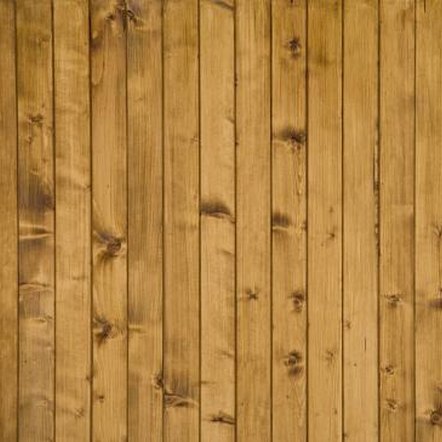
Pine paneling often has grooves that add visual interest, but these can make paint removal difficult.
Pine
is a soft wood that is easily gouged, so take care when you remove
paint and other coatings from pine paneling. While sanding can remove
one or two coats of paint from pine paneling, you’re often still stuck
with paint in the grooves. Chemical paint strippers simplify the process
of removing paint from pine paneling because they can get into the tiny
cracks and grooves, and are ideal for paneling that has more than a
couple of coats of paint. Removing paint from pine paneling is a
straightforward task that, with care, most homeowners can accomplish by
themselves.
1
Cover furniture and flooring with drop cloths or plastic sheets and apply painter’s tape to trim and molding. Open windows to keep the room ventilated, and put on rubber gloves, safety glasses and a painter’s mask.2
Brush a generous layer of paint stripper onto the paneling. Work in small sections so that the stripper does not dry before you scrape it off. Brush the stripper on in one direction. Liquid paint strippers are often the most effective formulas to use, but for vertical surfaces such as pine paneling on walls, a gel or paste will not drip or run as easily.3
Leave the paint stripper on the paneling for 15 to 20 minutes, or until the paint begins to bubble.4
Scrape the loosened paint with a plastic paint scraper or putty knife. Do not use metal tools to remove paint from pine paneling. The soft wood gouges easily.5
Scrub paint from grooves using medium to fine steel wool dampened with water. You can also use a stripping pad, which is a textured pad designed for this purpose, found at most paint stores.6
Rinse the paneling with a towel dipped clean water. You may have to reapply paint stripper if the paneling was coated with several layers of paint.7
Continue applying paint stripper and scrubbing and rinsing until you remove the paint from the entire surface.8
Allow the paneling to dry completely. Sand the surface of the paneling with fine-grit sandpaper to remove any remaining paint.9
Rinse the wood thoroughly a final time water and a clean towel, and dry with more clean towels before covering the paneling with new paint or a protective finish.Things You Will Need
- Drop cloths
- Painter's tape
- Gel or paste paint stripper
- Safety glasses
- Rubber gloves
- Painter’s mask
- Paintbrush
- Plastic scraper
- Medium to fine steel wool
- Water
- Stripping pad
- Towel
Warning
- The solvents used in paint strippers can be toxic or irritating to the skin and eyes. Wear protective clothing at all times and make sure the room you’re working in has adequate ventilation.

No comments:
Post a Comment